This website uses cookies so that we can provide you with the best user experience possible. Cookie information is stored in your browser and performs functions such as recognising you when you return to our website and helping our team to understand which sections of the website you find most interesting and useful.

Construction Redefined with Consolidated Management Software Technology
For construction companies, there has never been a more opportune time to upgrade your technology. With over 500 construction clients and a dedicated practice providing technology, CPA, tax and advisory services, whether you pursue a complete business transformation or are looking for greater process efficiencies and cost control, we can recommend your best course.
Sikich HEADSTART for Construction provides construction companies and related industries with an integrated construction software solution. Built on Microsoft Dynamics 365 Business Central, HEADSTART for Construction integrates your critical billings, estimating, documents, project management, labor, and financial information into one place; so, you can better manage budgets, schedules, field activities, customer relationships, and the bottom-line.
Discover how HEADSTART for Construction handles everything from finances to job quoting, job cost, subcontract management, resource management, progress billing and project management in a single, cloud-based system that helps everybody in the company manage their activities and report on the state of the business.
Get a copy of this white paper sent to your inbox

JOB QUOTES & MATERIAL PLANNING
MONITOR RESOURCES AND COMPILE DATA
JOB QUOTE REPORTS
- Create Job Quote based on “Job Segments” or “Job Tasks.”
- Create Job Templates with detailed planning lines.
- Create and identify “Scope of Work” necessary to accomplish job as proposed.
- Create Jobs from Job Quote upon acceptance and approvals.
- Job Quote Document for approval by customer.
JOB MATERIALS PLANNING
Track material requirements from planning lines and schedule materials to be ordered.
REQUISITION WORKSHEET
Create Purchase Orders by job or combine multiple jobs on Purchase Orders by Vendors.
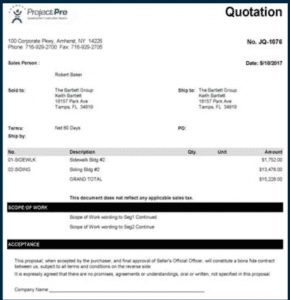
JOB QUOTE REPORTS
- Create Job Quote based on “Job Segments” or “Job Tasks.”
- Create Job Templates with detailed planning lines.
- Create and identify “Scope of Work” necessary to accomplish job as proposed.
- Create Jobs from Job Quote upon acceptance and approvals.
- Job Quote Document for approval by customer
JOB QUOTES & MATERIAL PLANNING CONT.
JOB MATERIAL PLANNING REPORT
- Provides the status of all required materials necessary for each job, including quantity required, and shows whether it’s on purchase order, requisitioned from inventory, received items, staged for delivery to job-site, already delivered to job, or if balance of job material is still required.
- Track materials required for specific jobs independent of job budgeted items.
- Manage when material items are needed by order dates and required on job-site dates.
- Manage whether to “Pull Inventory” or “Issue Purchase Orders” for items.
- Ability to “Stage” material items at designated location prior to delivery to job-site.
- Generate “Delivery Tickets” for items to pull from inventory and prepare vendor deliveries all on single delivery ticket to job-site.
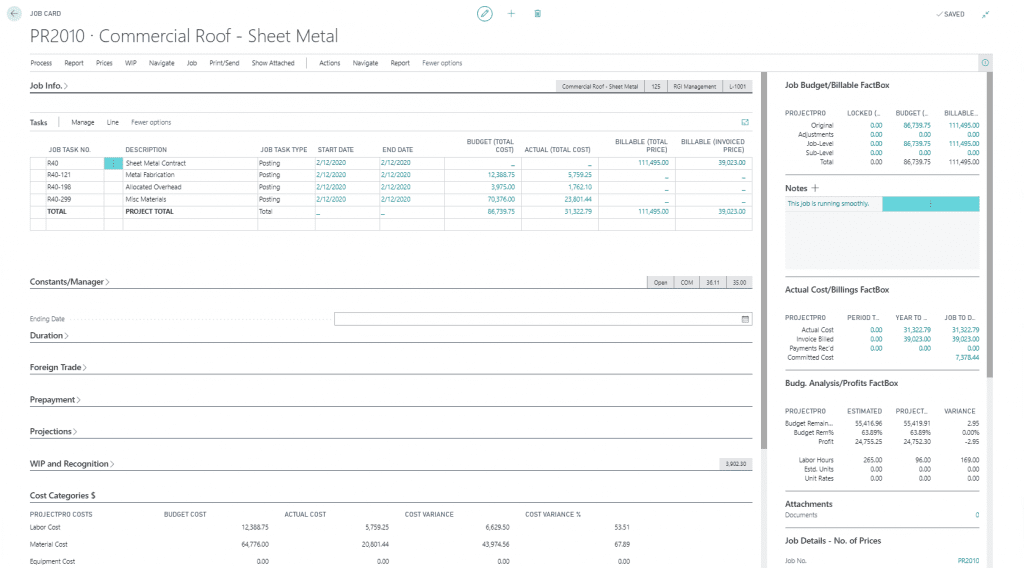
JOB COSTINg
MANAGE JOBS TO INCREASE EFFICIENCY
JOB BUDGET & CONTRACT
Manage original, adjustments, change order, and sub-level values.
COST CATEGORY SUMMARY
Compares budgeted costs, actual costs, variance, and percentage of variance.
JOB PROJECTIONS
Based on percentage of budgeted cost, units complete by job or individual task codes. Allows for creation of estimated cost to complete for recognized revenues & projected profits.
JOB ACTUAL COST & BILLINGS
Tracks actual cost, customer billings, payments received by current period, year-to-date, and job-to-date.
JOB STRUCTURE
Organizes and allows for master job, sub-jobs, change orders, extra work orders, or proposed work in a flexible and user-definable format.
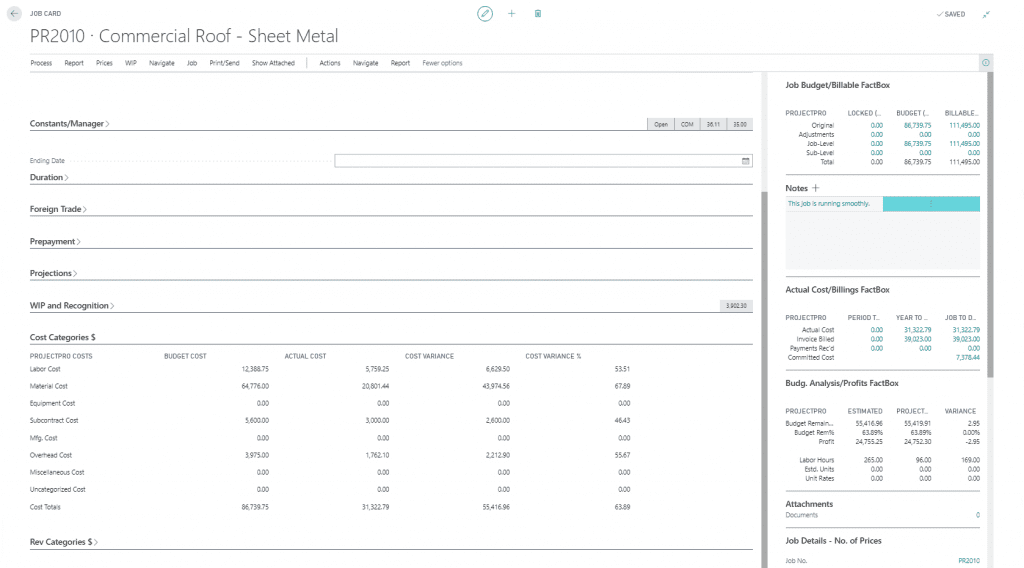
CRM INTEGRATION
Job Card CRM are directly related and identified as contacts into system database i.e. owners, contractors, construction managers, architects and engineers.
ADDITIONAL JOB INFORMATION
Compiles location, type, estimator, project manager, persons responsible, job status,% complete, back log, estimated start and finish dates, burden, and certified payroll into one place.
JOB PROGRESS BILLINGS
MONITOR JOB COSTS & PAYMENTS
PROGRESS BILLINGS CALCULATIONS
Bill customers based on progress of a project, by either percentage, units, or lump sum for each contract line.
PROGRESS BILLING VERSIONS
Easily change or reverse progress billings and their impact on job, financials, and customer billings.
PROGRESS BILLINGS REPORTS
Generic Progress Billing by Schedule of Value (Contract) – Bill by %, Work Units, Lump Sum$.
AIA G702 Progress Billing (American Institute of Architects)
Document.
AIA G703 Progress Billing – Continue Progress Billing continuous
detail sheet.
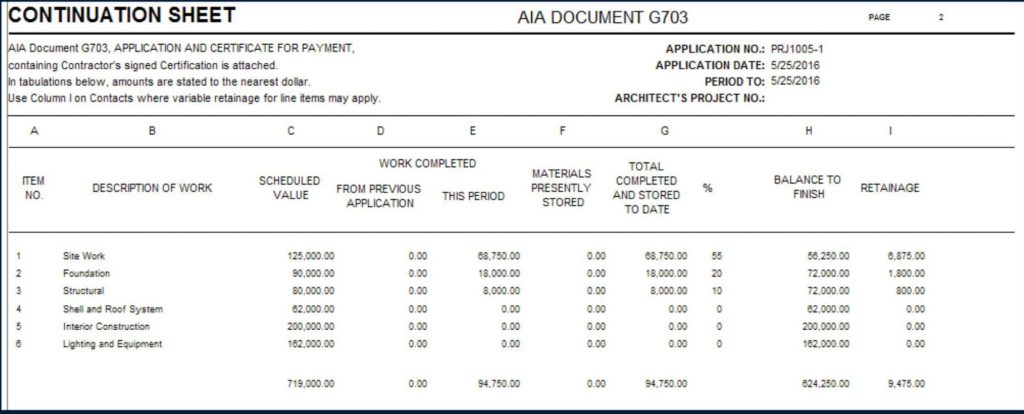
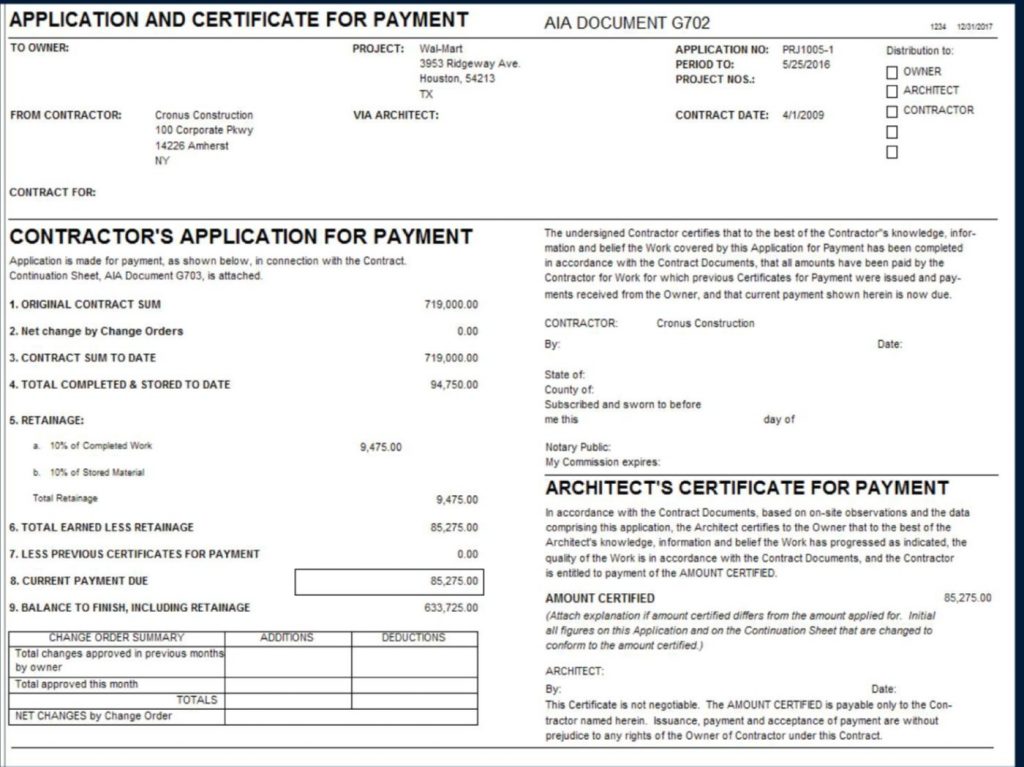
SUBCONTRACT MANAGEMENT
MANAGE SUBCONTRACTORS BUDGETS & TASKS
SUBCONTRACTS
Create reports based on subcontract status by either job or vendor codes, and subcontract invoices and payments.
SUBCONTRACT REPORTS
Generate subcontract agreements in Microsoft Word, get budget estimates and import subcontract tasks.
SUBCONTRACT CARDS
Track original subcontracts, change orders, create purchaseorders for vendors, and manage documents.
MANAGE SUBCONTRACT ACTIVITIES
Organize subcontractors by vendor ID or job number,
linking job task.
LIEN RELEASE WAVERS
Generate Progress and Final Lien Waivers with job, vendor,
and payment information referenced.
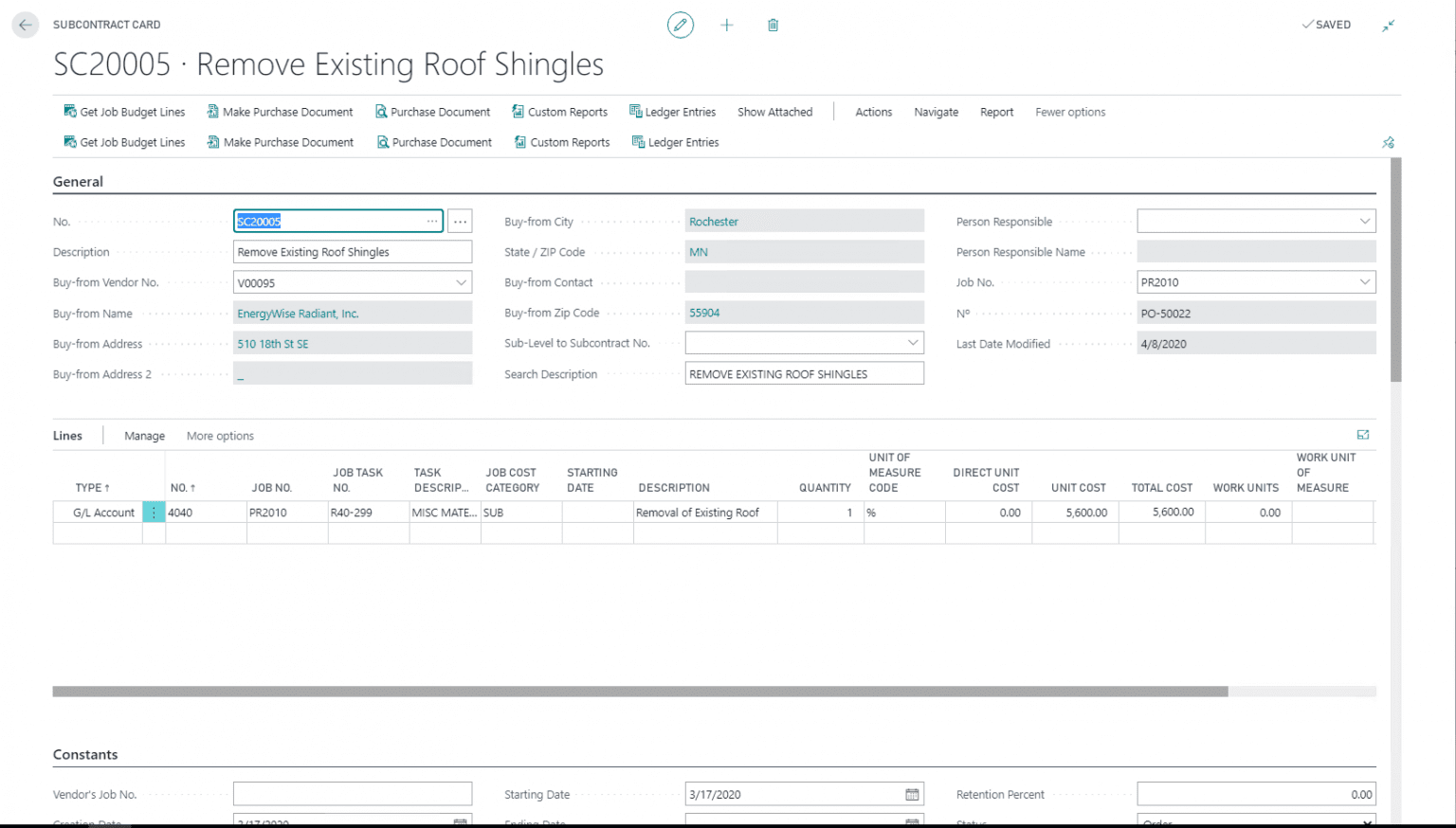
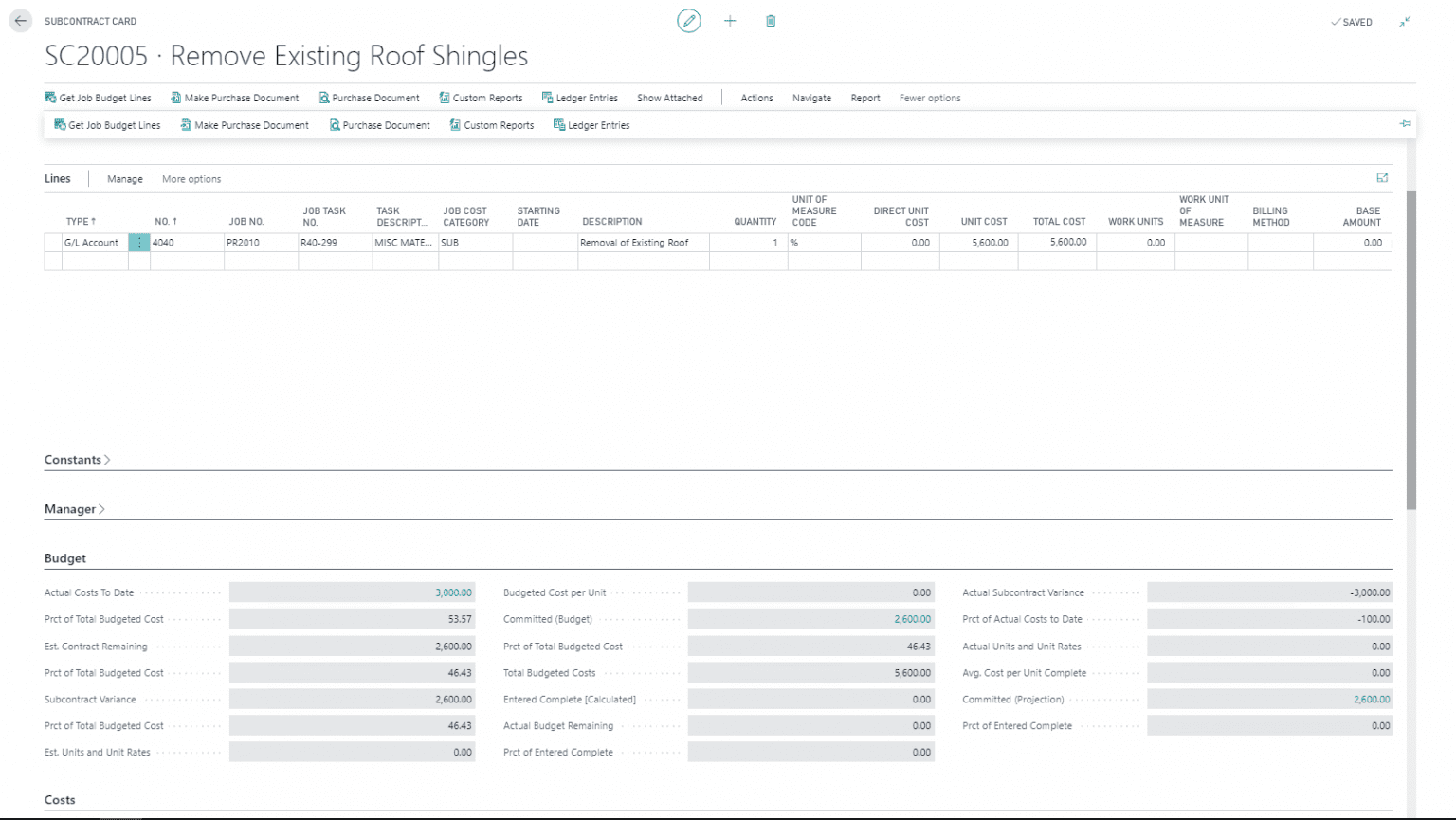
PAY-WHEN-PAID
Ability to pay subcontract invoice when customer pays invoice.
CERTIFICATES OF INSURANCE
Track insurance coverage and expiration date with alerts during vendor payment process.
PROJECT MANAGEMENT
PLAN & MANAGE ALL PROJECTS
PROJECT MANAGER
Create Job Forecast Worksheet Reports, which estimate “Cost to Complete” analysis by percentage, units, or dollars.
JOBS
Keep track of usage on jobs and data for invoicing the customer, manage both fixed-price jobs and time-and-materials jobs, create scheduled and budgeted job plans, and stay on track with suggested Work in Progress and Recognition postings.
TIME SHEET
Integrates the Service, Jobs, and Basic Resources modules to make for flexible time registration.
CAPACITY MANAGEMENT
Plan and manage capacity and sales usage statistics and profitability of resources, while monitoring resource usage to get a complete overview of your availability and costs for each resource.
MULTIPLE COSTS
Manage alternative costs for resources and resource groups with the ability to define as many work types as you need.
CAPACITY MANAGEMENT
Plan and manage capacity and sales usage statistics and profitability of resources, while monitoring resource usage to get a complete overview of your availability and costs for each resource.
JOBS SETUP WIZARD
Set-up jobs, enter time sheets, and log job journals with ease using the project manager role center to quickly access common tasks, charts, and lists.
MULTIPLE CURRENCIES
Ease of communication with international companies with multiple currency invoices.
BASIC RESOURCES
Keep track of resources and prices, register and sell resources, and allocate resources to specific jobs.
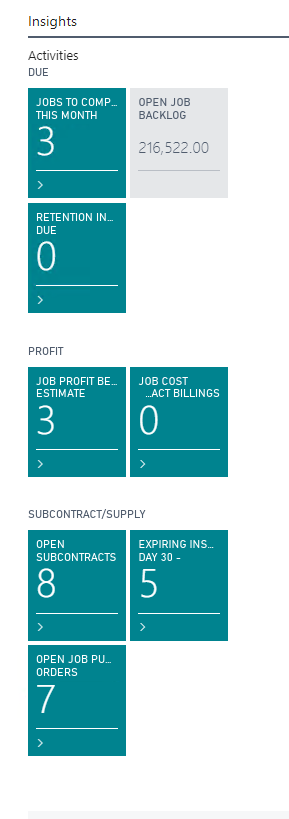
SERVICE MANAGEMENT
MONITOR SERVICE JOBS
SERVICE ORDER MANAGEMENT
Register your after-sales issues including service requests, services due, service orders, and repair requests.
SERVICE PRICE MANAGEMENT
Set up, maintain, and monitor your service prices based on parameters you set – such as the service item, service task, or type of fault-for a limited period of time, or for a specific customer or currency.
WORKFLOW MANAGEMENT
Manage approvals, receive notifications, and allow process automation to ease business processes and allow for facilitated decision making.
SERVICE CONTRACT MANAGEMENT
Maintain information on contract history, contract renewal, contract templates, warranty details, service levels, contract profitability, and generate contract quotes.

PLANNING AND DISPATCHING
Assign personnel to work orders and log details such as work order handling and work order status.
Dispatch and manage service personnel and field technician information, and filter according to availability, skills, and stock items.
SALES & MARKETING MANAGEMENT
ORGANIZE CUSTOMER & BUSINESS INFORMATION
RELATIONSHIP MANAGEMENT
Simplified CRM you can access from your mobile device, giving you 24/7 access to contact management, interactions, and sales opportunities.
CONTACT CLASSIFICATION
Sort your contacts into categories, and automatically classify your customers based on criteria you specify, allowing you to target contacts for campaigns.
CONTACT MANAGEMENT
Maintain an overview of your contacts, record contact information for all business relationships, and personalize your approach to them.
OPPORTUNITY MANAGEMENT
Keep track of and manage sales opportunities by sectioning your sales
processes into different stages.
OUTLOOK CLIENT INTEGRATION
Synchronize your to-do items and your contacts in Microsoft Dynamics 365 Business Central with meetings, tasks, and contacts in Outlook.
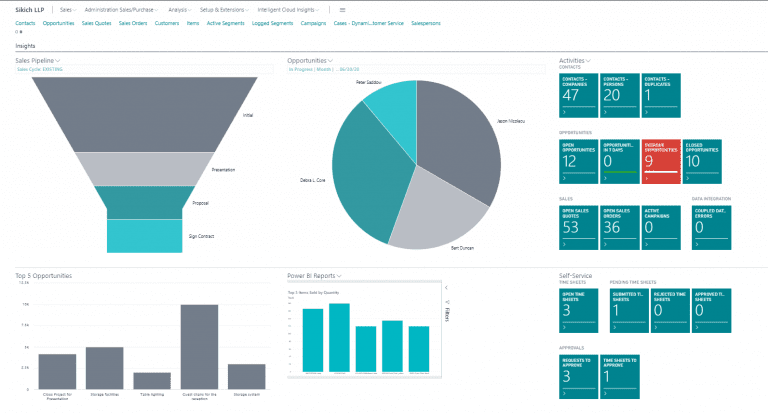
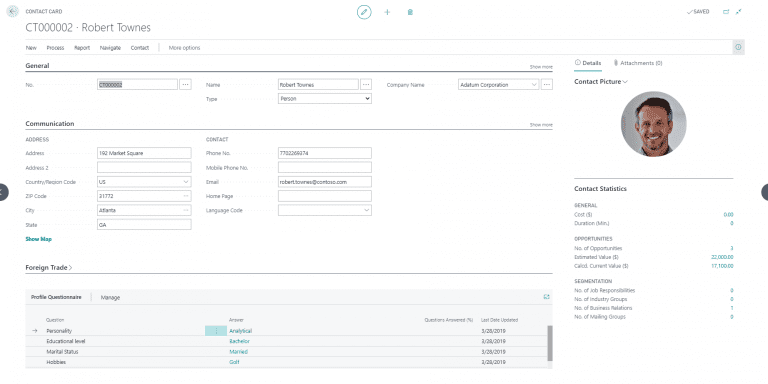
TASK MANAGEMENT
Create to-do lists for yourself and assign tasks to other users/teams of users.
INTERACTION/DOCUMENT MANAGEMENT
Record all interactions with contacts – e.g. telephone calls, meetings, letters.
JOB RESOURCE SCHEDULING
MANAGE PROJECT TIMELINES
VISUAL JOB SCHEDULER
- Set up, track, and view project schedules for both budgeted and non-budgeted jobs.
- Utilize budgets and job task planning lines to visualize job activities.
- Plan tasks and services by date.
- See which resources, crews, equipment, and subcontractors are scheduled to which jobs and see the impacts on job deliverables and milestones with changed dates.
- Easily alter the time frame and order of tasks through predecessor/successor relationships.
- Analyse pre-defined reports i.e. Detailed Schedule and Summary Schedule.
- Create Job Payroll Entries from Posted Job Transactions for Payroll Services.


FINANCIAL MANAGEMENT
FINANCES MADE EASY
GENERAL LEDGER
All the basic functionality necessary for setting up a company and posting to the general ledger, chart of accounts, general journals, VAT facilities, recurring journals, and source codes. Allocate entries to combinations of accounts, departments, and projects based on amount, percentage, or quantity.
ACCOUNT SCHEDULES
Extract the most essential business data from the chart of accounts,
budgets, cash flow accounts and cost types into financial reports to monitor the health of the business and ease decision making.
BUDGETS
Set up deferral templates that automate the process of deferring revenues and expenses over a pre-defined schedule.
DEFERRALS
Manage cycle counting, a basic method of verifying inventory record data used to maintain and increase inventory accuracy.
INTER-COMPANY POSTINGS
Manage accounting for more than one company in the same posting process, send documents to partner companies.
CASH MANAGEMENT
Manage bank account information with multiple currency capability, manage electronic payments and direct debits, reconcile incoming and outgoing bank transactions, generate computer printed checks, and reconcile bank statement data automatically.
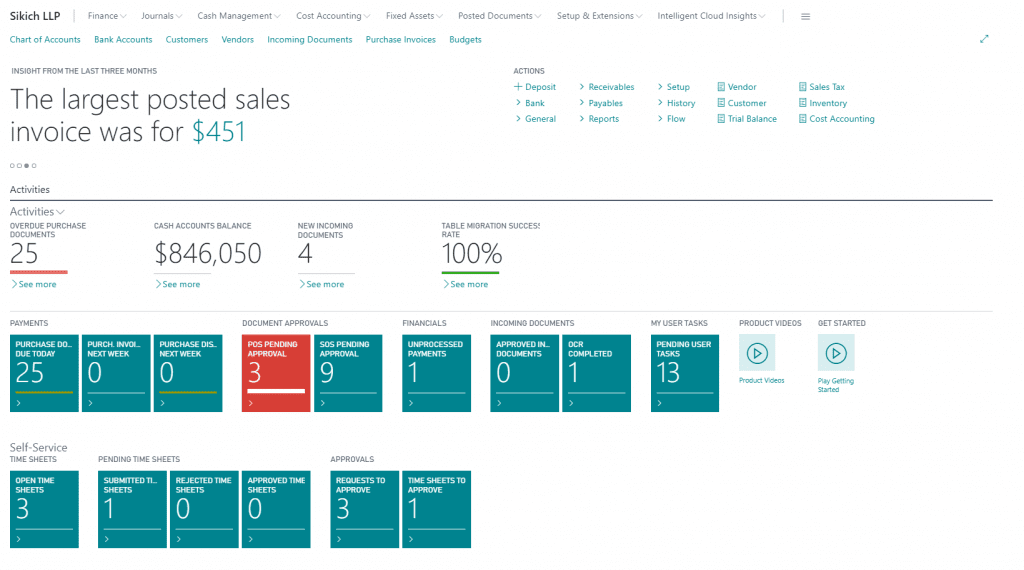
CASH FLOW FORECAST
Predict how a company’s liquidity-cash and other treasury positions-will evolve over time, consisting of cash receipts and cash disbursements.
ADVANCED DIMENSIONS
Establish an unlimited number of reporting dimensions with the capability to establish rules for validations (e.g. combinations) that increase the reliability of outputs based on those dimensions.
FIXED ASSETS
Keep track of fixed assets such as buildings, machinery, and equipment and stay updated with various fixed-asset transactions: acquisitions, depreciation, write-downs, appreciation, and disposal.
ACCOUNTS RECEIVABLE
MANAGING SALES & RECEIVABLES
BASIC RECEIVABLES
Post sales transactions in journals and manage receivables; register
customers and manage receivables using general journals with the
capability for multiple currencies for each customer.
ALTERNATIVE SHIP-TOS
Set up multiple ship-to addresses to accommodate customers that have more than one site to which orders can be shipped.
Monitor resource usage to get a complete overview of your availability and costs for each resource.
SALES TAX
Calculate Sales Tax and Use Tax and set up individual tax areas for each customer and vendor.
SALES RETURN ORDER MANAGEMENT
Create sales return orders to compensate a customer for wrong or damaged items.
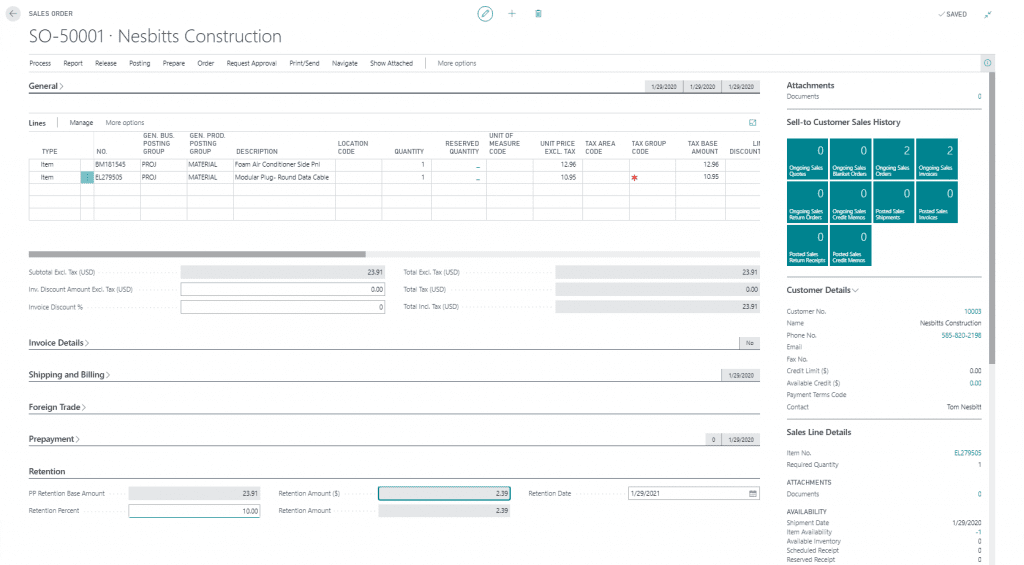
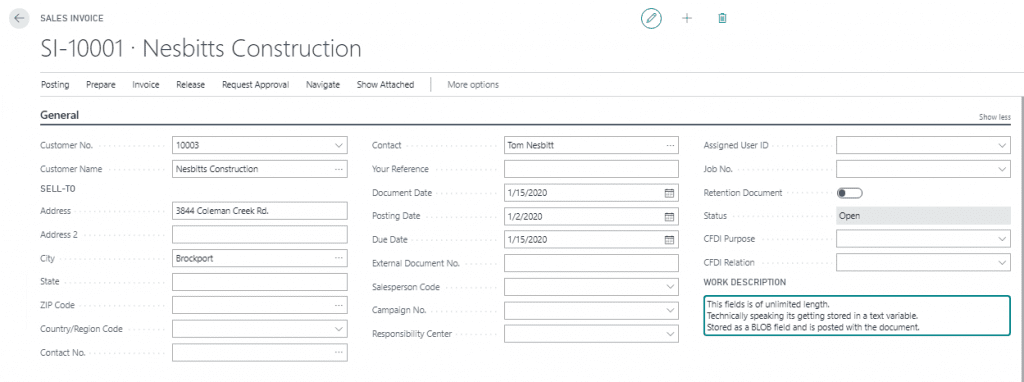
SALES ORDER MANAGEMENT
Manage sales quotes, blanket sales orders, and sales order processes including shipments and deliveries.
Ship and invoice separately, manage partial shipments, and create prepayment invoices for sales orders.
PAYROLL SERVICES
SIMPLIFY TIME ENTRY
DAILY ENTRY
- Mobile time entry capability.
- Post-labor to jobs on a daily basis from Job Journals or Time Sheets.
- Create Job Payroll Entries from Posted Job Transactions for Payroll Services.
PAYROLL APPROVAL
Managers approve employee time entries before processing.
MANAGE WAGES
Establish wages and benefits by job and skill where the employee will
automatically be paid the higher of ”Home Wage rate” or “Job Wage rate”, and include benefit differentials as well.
ADDITIONAL COSTS TO JOBS
Create Burden for labor posted to jobs – such as: Taxes, Insurances, other burdens.
ADVANCED LABOR REPORTS
Create easy reports e.g. Payroll Prooflist, Payroll Test Report, and Certified Payroll Report (WH-347).
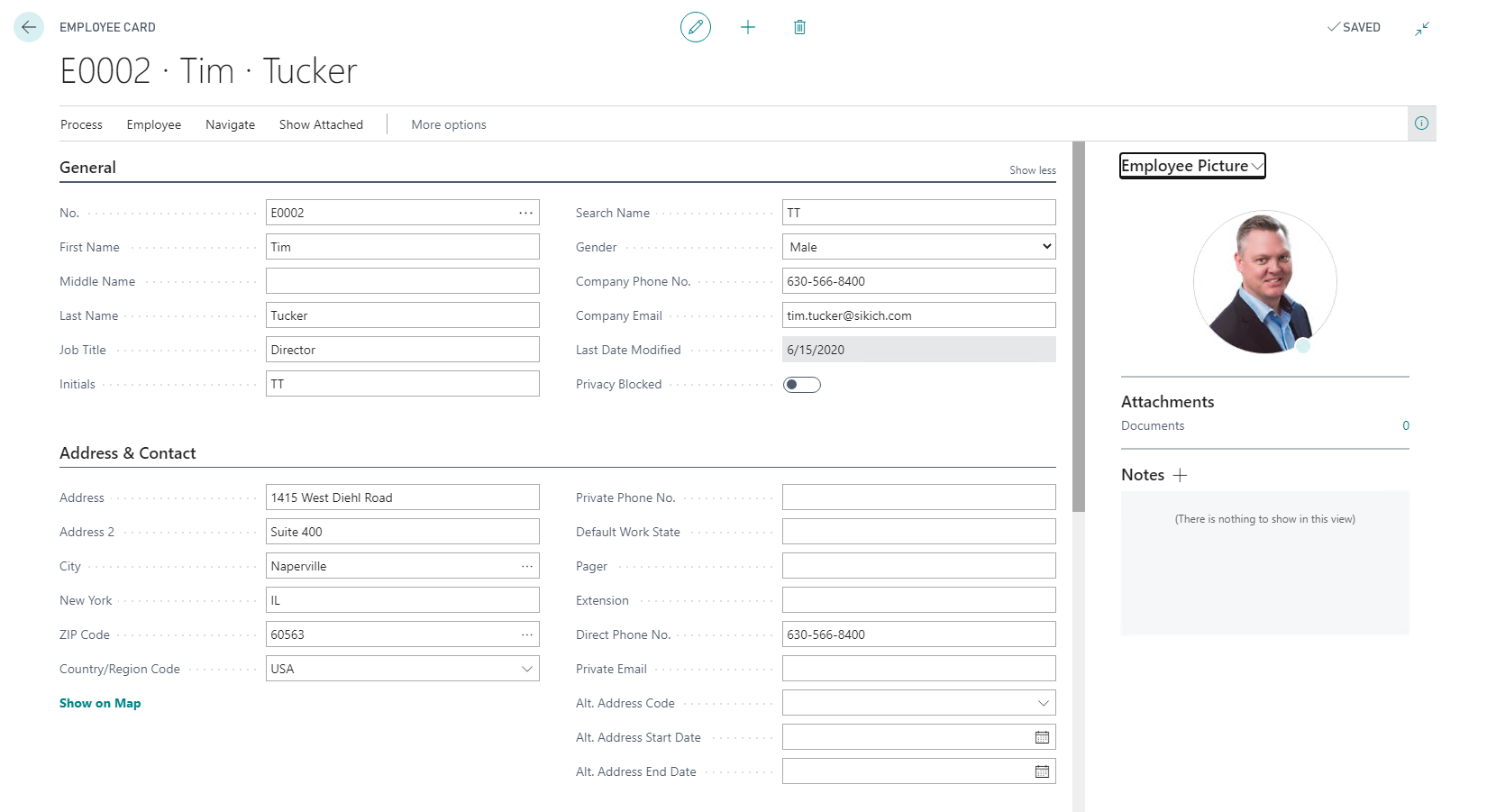
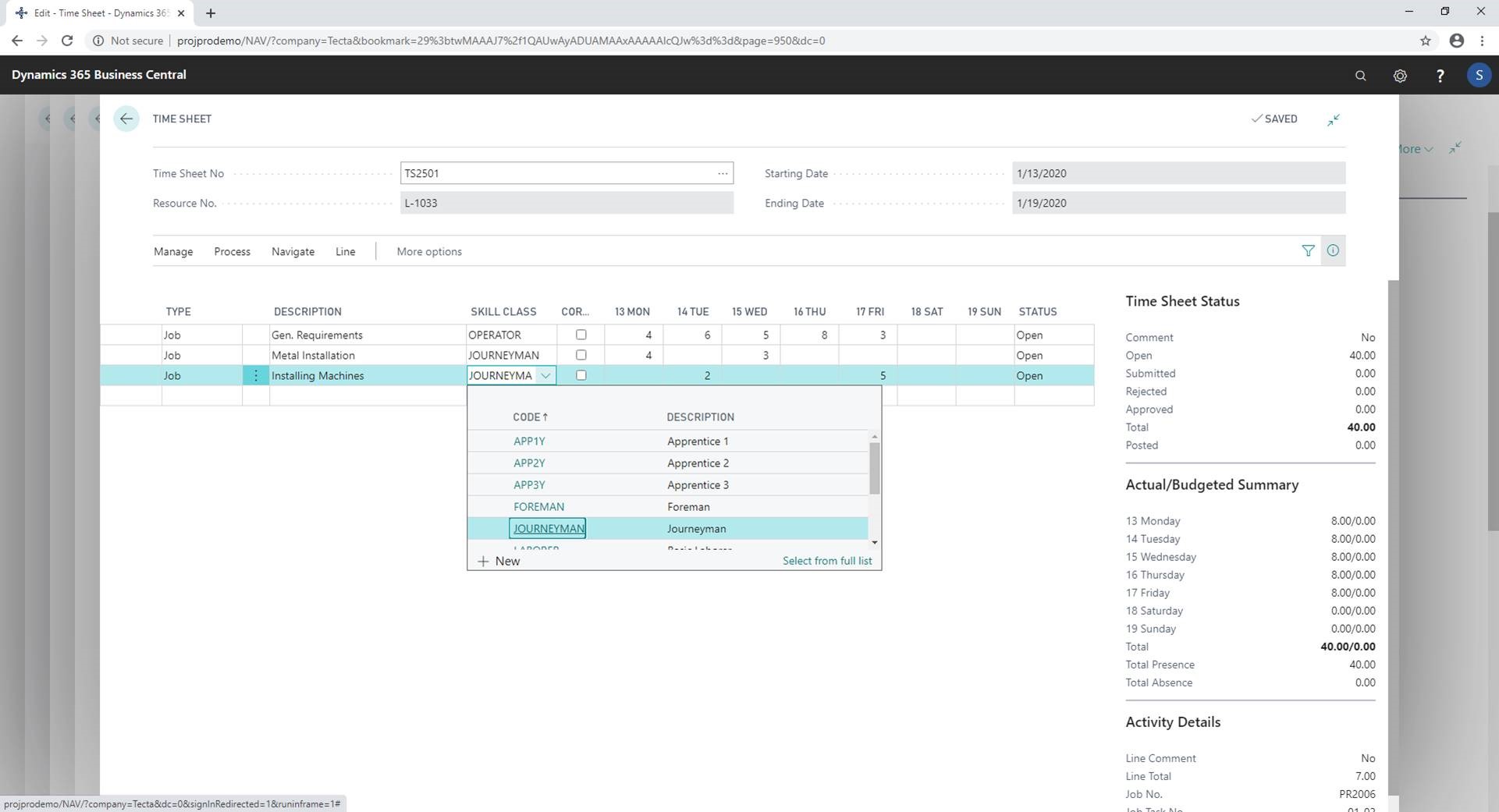
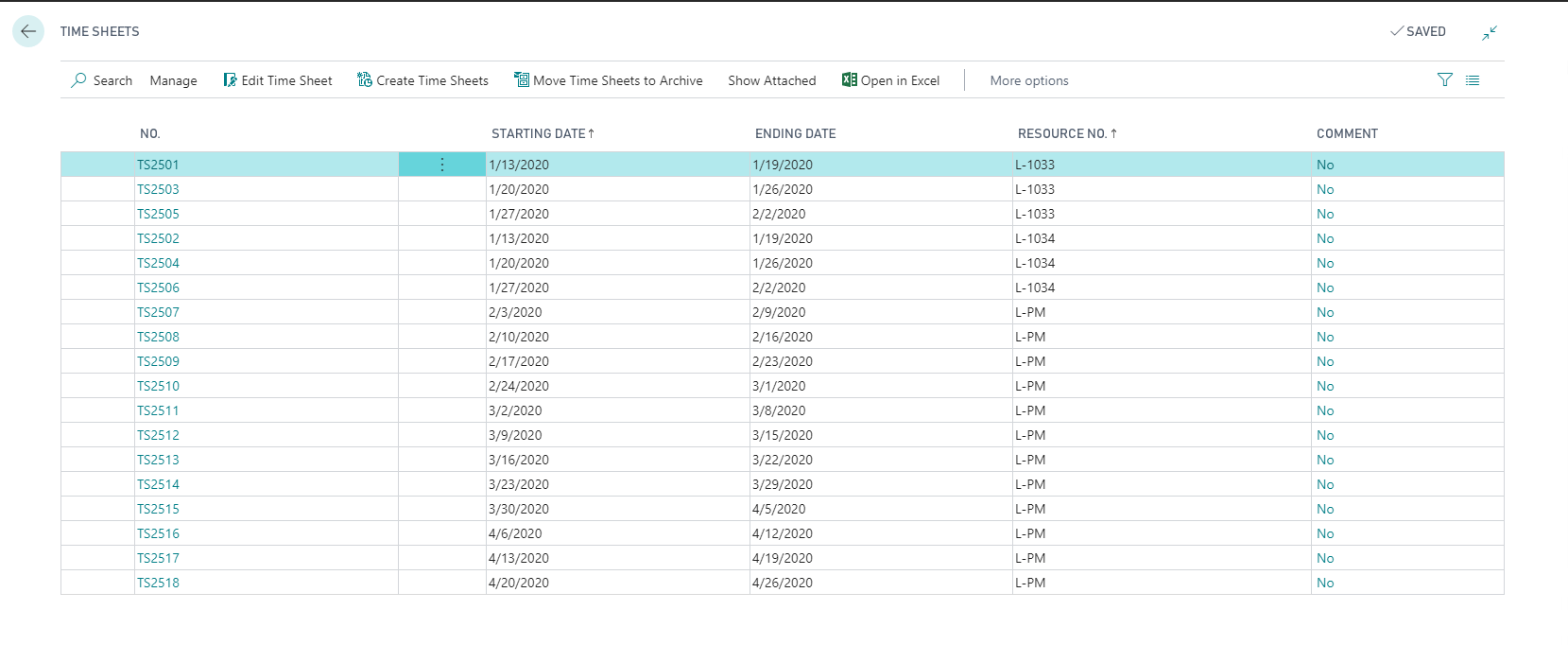
PAYROLL SERVICES
Choose between an internal payroll option or integration with a payroll service: ADP®, Paychex®, Kenek® and Paylocity®.
Integrates with HCM (Payroll) Serenic and PayMate (Clarity).
Import processed Weekly Payroll Register back in to ProjectPro for “Certified Payroll Reports.”
TIME & MATERIALS
MONITOR TIMELINES & HANDLE RESOURCES
TRACK & MARK UP EXPENSES
Mark up job expenses by job, customer, or company by labor, material, subcontracts, equipment, excess burden, etc. Define custom markups by percentage, a fixed rate, additional amounts, and more.
Ensures accurate data and reduces company error.
JOB TIME AND MATERIAL BILLINGS
Generates time and material invoices as needed.

ACCOUNTS PAYABLE
JOB PURCHASING & MANAGEMENT
BASIC PAYABLES
Set up and maintain a vendor table, post purchase transactions in a journal, manage payables, and generate vendor ledger entries using general journals.
PURCHASE ORDERS
Facilitates purchases by integrating an enhanced payment process (through subcontracts, pay-when-paid, and change order transactions) with order and invoice forms availability and costs for each resource.
PURCHASE INVOICING
Enhanced retention of tracking and accounting services.
PURCHASE RETURN ORDER MANAGEMENT
Create a return order for wrong/damaged items.
REQUISITION MANAGEMENT
Generate optimal suggestions for replenishing inventory through purchases and transfers based on the item’s current and future demand and availability.
PURCHASE ORDER MANAGEMENT
Manage purchase quotes, blanket orders, purchase order processes, partial receipts, resources, and job specific purchases as well as create prepayment invoices.
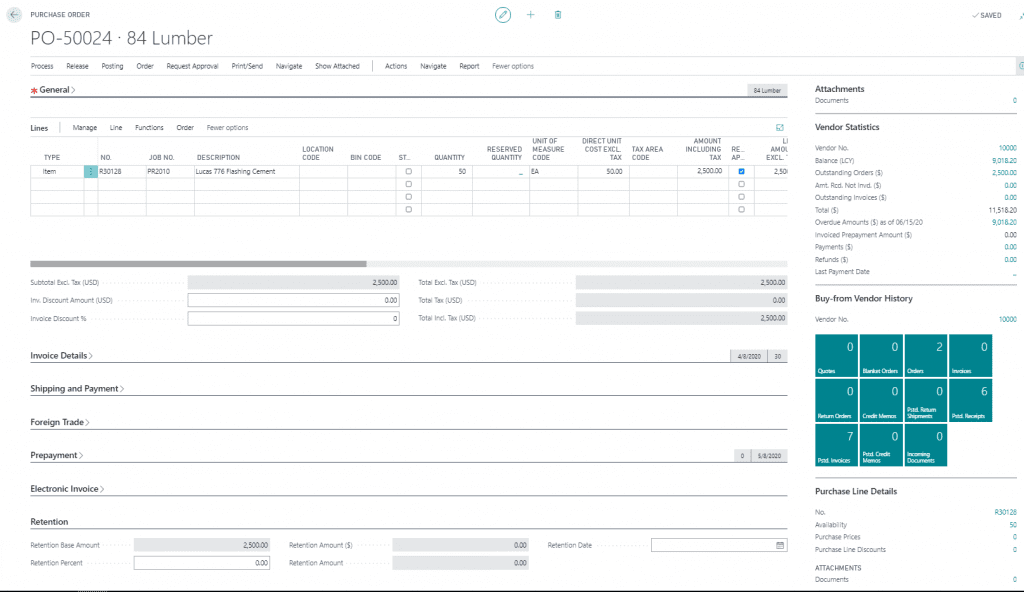
DROP SHIPMENTS
Handle order shipments directly from the vendor to the customer without having to physically stock items in your inventory while still keeping track of order costs and profit.
ALTERNATIVE ORDER ADDRESSES
Set up multiple addresses to manage orders from vendors that have more than one site from which they ship orders.
AGED PAYABLE REPORTING WITH RETENTION
Enhanced retention of tracking and accounting services.
INVENTORY & EQUIPMENT
TRACK & LOCATE ALL ITEMS
INVENTORY
Set up items that you carry in your stock and specify their unit of measures, costing method, inventory posting group, unit cost and price and other properties.
View sales dynamics, analyze inventory turnover, evaluate customer buying behavior, spot trends, and reconsider product offerings, prices, and vendors to make informed business decisions.
ITEM CHARGES
Include the value of additional cost components such as freight or insurance into the unit cost or unit price of an item.
REQUISITION WORKSHEET
Calculate inventory required for min/max, sales orders, manufacturing, jobs and services.
NON-STOCK ITEMS
Offer items to customers that are not part of your regular inventory but that you can order from the vendor or manufacturer on a one-off basis.
ITEM CROSS REFERENCES
Quickly and precisely identify the items a customer is ordering on the basis of item numbers other than your own.
BIN ASSIGNMENT
Organize your warehouse by assigning items to bins, the smallest unit in the warehouse logical structure.
CYCLE COUNTING
Manage cycle counting, a basic method of verifying inventory record data used to maintain and increase inventory accuracy.

ITEM BUDGETS
Make sales and purchase budgets on customer, vendor, and item levels, and in both amounts and quantities.
ALTERNATIVE VENDORS
Manage the purchase of the same item from several different vendors by associating price, discount, & delivery agreements for that item specific to each vendor.
ITEM SUBSTITUTIONS
Link items with the same or similar characteristics so that if a customer orders an item that is unavailable, you can offer substitute items and avoid losing the sale.
CAPACITY MANAGEMENT
Plan and manage capacity and sales usage statistics and profitability of resources, while monitoring resource usage to get a complete overview of your availability and costs for each resource.
ITEM TRACKING
Manage and track serial and lot numbers, assigned either manually or automatically.
STANDARD COST WORKSHEET
Maintain accurate and up-to-date, inventory costs in the same way as you’d use an Excel spreadsheet.
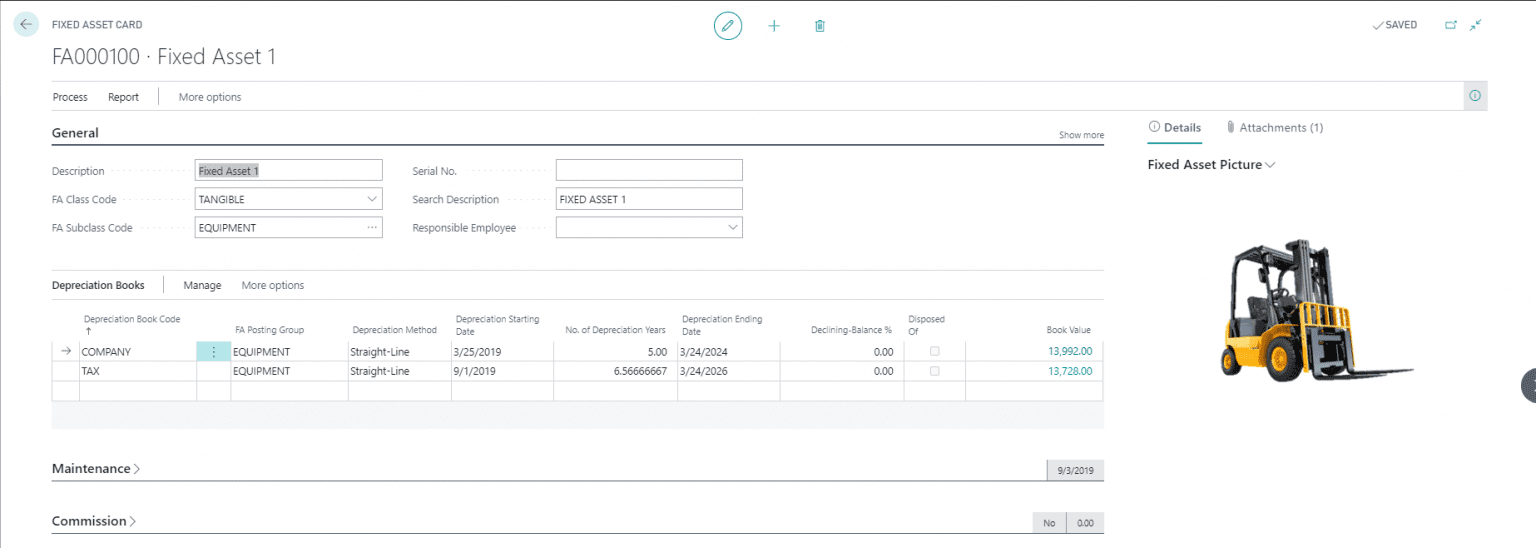
DOCUMENT CAPTURE & ROUTING
CONSOLIDATE YOUR WORKFLOW
ELECTRONIC FILING CABINET CAPABILITIES
- Automatic analysis of data captured from scanned images.
- Predefined document templates automatically enter data into the correct fields.
MATCH PURCHASE ORDERS
Advanced features match purchase invoices with existing purchase orders.
SALES ORDERS
Define new document types and fields that are relevant to your business.
DRAG-AND-DROP
Attach any file or email to any record in NAV.
FULL-TEXT SEARCH
PDF files are fully indexed allowing full-text searches through all document data.
CAPABILITIES
Streamline and automate every step of daily document handling – from receiving and registering a document,
to approval, posting and ultimately retrieving previously processed documents from the digital archive:
- Automated Data-Capture
- Invoice Processing & Management
- Approval Workflows for Everyone
- Access Documents from
Everywhere
FIELD MOBILE SOLUTIONS
LIVE DATA AT YOUR FINGERTIPS
- Offline capability & Independent of the network coverage.
- Support your service technician in their daily work: easy access to all
important data, such as service orders, service products and customers
from Dynamics to your tablet PC or smart phone.
AT CUSTOMER SITE
Time Entry, Service Item Details, Service Tasks and Dictionaries, Take a Photo, Add Items, Finish Service Order.
READY TO USE
- Work Offline, Synchronization, Print Service Report, write e-mails, make phone calls, use navigation and capture photos.
- Use the camera of your mobile device as a barcode or QR scanner to capture items based on their barcodes.
PHONE, COMPUTER, OR TABLET ACCESSIBILITY
- Access to data from any mobile device – Available for iOS, Android, and Windows.
- Mobile ERP allows work on the go or at home.
- Real-Time data helps you stay on top of your projects

INDUSTRY SPECIALIZATION
PARTNERING WITH SIKICH
For over the last 35 years, Sikich has helped hundreds of Construction and related companies meet their strategic goals, grow their business, and achieve successful project outcomes. Behind our digital practices sits one of the largest and most reputable accounting and advisory businesses in the US. Sikich has an experienced and skilled management team dedicated to construction and related industries and understands the challenges you face. Our technology clients have full access to services like investment banking, business valuation, tax and accounting.
Sikich meets your company where you are today and helps you get to where you want to be, with a broad range of business services to help you throughout the life-cycle of your business.

TECHNOLOGY
- Digital Transformation
- Remote Work Enablement
- Information Security & Compliance
- ERP Lifecyle Services
- CRM Lifecyle Services
- Managed IT Services
- Information Security & Compliance
- Cloud Migration
ACCOUNTING, TAX & AUDIT
- Industry Financial Statement & Tax Planning Services
- Real Estate Investment Structuring
- DOT Compliance
- HUD Compliance
- Integrated Project Delivery (IPD) Consulting and Compliance
- Tax Credits
- Like Kind Exchanges
- State and Local Tax Services
- Sales and Use Tax Consulting
- Cost Segregation Studies
ADVISORY
- Human Resources
- Internal Controls
- Business Process Improvement
- Dispute and Litigation Advisory




